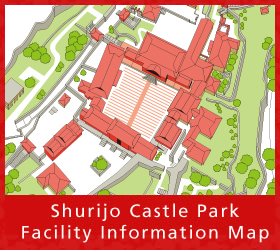The Road to the Seiden
Home > Facility Information > The Road to the Seiden
Free Admission Area
Travel Back in Time to the Period of the Ryukyu Kingdom
Here, we will introduce the way to the Seiden from the parking lot at Suimuikan and through the Shureimon.
Shureimon / Sonohyan-Utaki Ishimon / Kankaimon / Ryuhi / Sappo Shichihi / Zuisenmon / Roukokumon / Nichieidai / Bankoku Shinryo no Kane
Shureimon
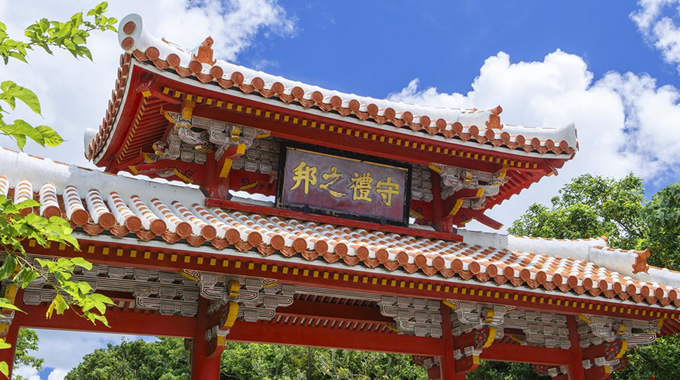
Shurei means to “observe proprieties” and on the framed wooden plaque hanging above this gate are the characters that read Shurei no Kuni, meaning “Ryukyu Kingdom is a land of propriety”. Shurijo Castle has many stonewalls and castle gates, but the Shureimon gate has a well-balanced design and an elegant atmosphere. This gate, which represents Shurijo Castle, is constructed in the traditional Chinese architectural style of Pailou.
Many of the gates and structures at Shurijo Castle have alternative names aside from their official names and from them, we can see the poetic sentiments of the ancient Ryukyuan people. Long ago, Shureimon was also called the Shurimon, but the commoners called it “Iino Ayajo” with endearment, as it means “the beautiful gate at the top”.
Shureimon was first constructed between 1527 and 1555 (during the reign of King Sho Sei, the 4th king of the Second Sho Dynasty), and it was designated as a National Treasure in 1933, but it was destroyed in the Battle of Okinawa. The gate was reconstructed in 1958 and since then, it continues to be a symbol of Okinawa and draws many visitors. Shureimon is also featured on the 2,000 Yen notes which were printed in commemoration of the year 2000.
Sonohyan-Utaki Ishimon
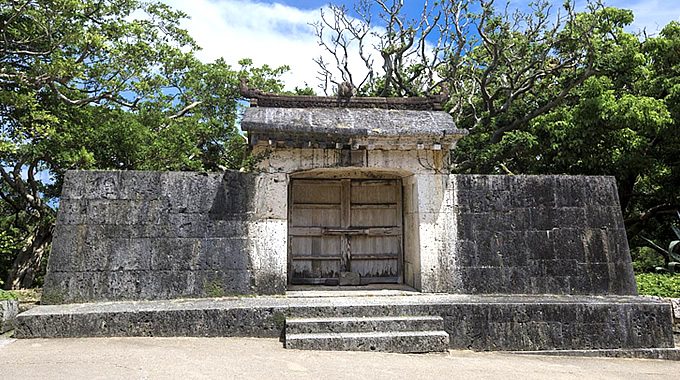
The structure is made with Ryukyu limestone and was a sacred site where the king came to pray for a safe journey whenever he left the castle. The shape is that of a gate, but its purpose was not a passageway for people, but rather, it was a “gateway to pay respects” to the gods.
From the framed wooden plaque placed at the top of the gate, we know that it was constructed in 1519 (during the reign of King Sho Shin). It is said that a government official by the name of Nishito, who was from Taketomi Island in Yaeyama, was responsible for its construction.
This is one of the representative stone structures of Ryukyu and was designated as a National Treasure in 1933, but it was partially destroyed in the Battle of Okinawa. It was restored in 1957 and presently, is nationally designated as an Important Cultural Property. It was also registered as a World Heritage Site in the year 2000.
Kankaimon
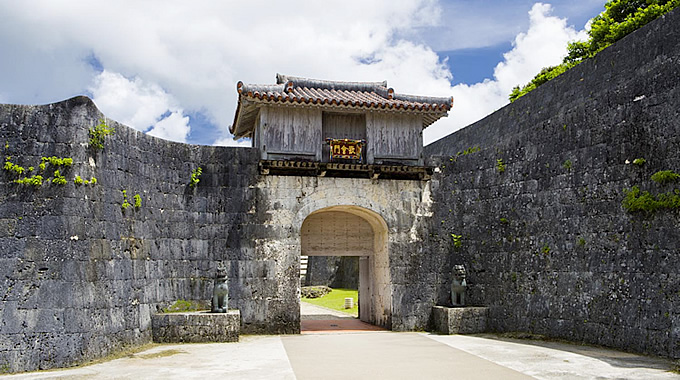
This is the first gate that leads to the inner castle walls of Shurijo, and the name Kankai means “to welcome”. Long ago, Chinese envoys dispatched by Chinese emperors were invited to Shurijo Castle, and this gate was named Kankaimon to welcome these important guests.
Shurijo Castle is surrounded by two walls, one for the outer ward and another for the inner ward. This is the first gate of the outer ward and was also referred to as Amae Ujo. In the ancient language of the Ryukyus, Amae meant “a joyous occasion”.
Kankaimon was constructed between 1477 and 1500 (during the reign of King Sho Shin), but it was destroyed in the Battle of Okinawa, and rebuilt again in 1974. There is a wooden turret on top of the arched stone gate, a style that we can see in Kyukeimon, Keiseimon, and others.
On both sides of the gate are Shisa, a pair of stone Shishi lions. The Shisa are placed here for protection and to ward off evil.
Ryuhi

Ryuhi was given its name taken from how the spring water flows from the mouth of the dragon. The water drawn from this spring was served as drinking water for the royal palace. It is also said that water was carried from here to the Tenshikan by Naha Port for the Sapposhi, or the Chinese envoys dispatched by their emperor, who were accommodated there.
The sculpture was brought from China in 1523 and is approximately from 500 years ago.
Sappo Shichihi
Sappo Shichihi are the seven stone tablets (shichi-hi) placed near the Ryuhi.
The Sapposhi, or the investiture envoys sent by Chinese emperors, came to the Ryukyus to declare the ascension of a new king to the throne. These successive envoys praised the purity of the water that flowed from the Ryuhi and composed Chinese poetry and left numerous writings. These tablets were destroyed in the Battle of Okinawa and little remains today. However, in an excavation conducted in 1984, a piece of a tablet was discovered with the inscription, “飛泉 (Hisen)”, and it was determined that it was the other half to a tablet stored at the Okinawa Prefectural Museum, which was inscribed with the characters, “漱玉 (Sogyoku)”. This discovery drew much attention at that time. The completed tablet with the inscriptions, “飛泉漱玉 (Hi Sen So Gyoku)”, speaks of how the pure and clear water from the Ryuhi was splashing like beautiful beads. The seven tablets placed here today were restored from rubbed copies. The inscriptions, its writers, and the general meanings are listed below.

Inscription: 中山第一(Chu Zan Dai Ichi)
- Writer: Jo Hokou(Xu Baoguang)
- Came to Ryukyu: In 1719
- Outline: The volume and quality of the water at this spring is the best in all of Ryukyu.

Inscription: 雲根石髄(Un Kon Seki Zui)
- Writer: Zen Kai(Quan Kui)
- Came to Ryukyu: In 1756
- Outline: Flowing through the openings high in the mountains, the spring is milk of the stones.

Inscription: 暘谷霊源(Yo Koku Rei Gen)
- Writer: Cho Bunkai(Zhao Wenkai)
- Came to Ryukyu: In 1800
- Outline: A mysterious and wonderful spring in the farthest east, where the sun rises.

Inscription: 活潑潑地(Katsu Hatsu Hatsu Chi)
- Writer: Sei Kon(Qi Kun)
- Came to Ryukyu: In 1808
- Outline: The flow of the spring is lively like a fish jumping out of water.

Inscription: 源遠流長(Gen En Ryu Cho)
- Writer: Rin Konen(Lin Hongnian)
- Came to Ryukyu: In 1838
- Outline: The source of the spring is far and the stream flows a great distance.

Inscription: 飛泉漱玉(Hi Sen So Gyoku)
- Writer: Ko Jinkan(Gao Renjian)
- Came to Ryukyu: In 1838
- Outline: The pure and clear water of the spring splashes like beads.

Inscription: 霊脈流芬(Rei Myaku Ryu Fun)
- Writer: Cho Shin(Zhao Xin)
- Came to Ryukyu: In 1866
- Outline: A fragrant flow of water from a miraculous water source.
Zuisenmon
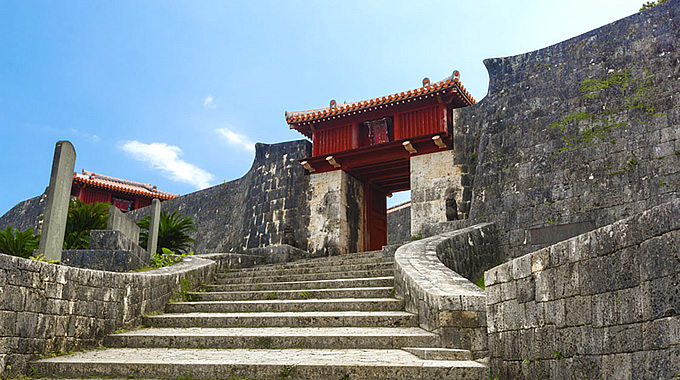
Zuisen means “a great, auspicious spring”.
The water spring at the front-right of the gate is called Ryuhi, and this is how Zuisenmon got its name. This is the second gate leading to the castle and Zuisenmon is also called Hikawa Ujo.
The “Hi” in Hikawa Ujo points to the long pipes that direct the water from rivers and springs, or trenches, and water trough that collects the rainwater from rooftops. In Okinawa, water wells and springs are referred to as Kawa or Kaa. Hikawa is a combination of these words, and can be pronounced Fiija-Gaa.
Zuisenmon was constructed around 1470, but it was burned and destroyed in the Battle of Okinawa, and then reconstructed in 1992. On both sides of the gate are stone Shishi lions, and they are placed there for protection against evil.
Unlike the arched stone gate of Kankaimon, the Zuisenmon has a turret directly on top of the double-walled gate. This type of Yaguramon gate can be seen in castle gates in mainland Japan, but the framed wooden plaque with the words Zuisen placed at the center of the turret has a unique Ryukyuan style.
Roukokumon
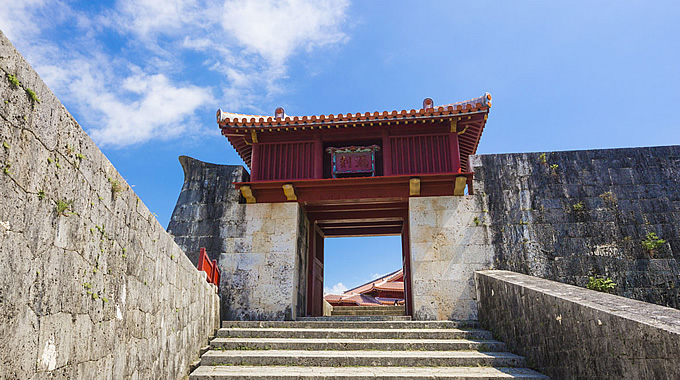
In Chinese, Roukoku means “water clock”. The Roukokumon is the third gate leading up to the castle and is also referred to as Kago-Ise Ujo.
During the period of the Ryukyu Kingdom, high ranking officials arrived at Shurijo Castle in palanquins (kago). Even such officials showed respect to the king by stepping out from their palanquins at this location. This is how Roukokumon also came to be known as Kago-Ise Ujo. The gate was constructed around the 15th century.
It is said that a water tank was set at the turret on top of the gate, and the amount of water that fell measured the time. Once the time was measured, an official in charge pounded on a drum. Upon hearing the drum, other officials immediately struck large bells simultaneously at the Agari-no Azana and Iri-no Azana, as well as at Uekimon. This was how the people kept time within the castle and also beyond the castle walls.
This Roukoku system is recorded in a Korean document from 1456, which stated, “This (system in Ryukyu) is no different than the system we have in our own country.”
Nichieidai
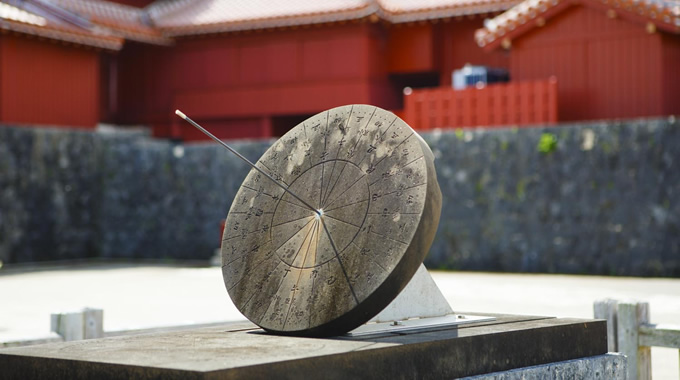
Placed directly in front of Roukokumon is the Nichieidai, a sundial. It was placed at this location in the bygone era and was used as a tool to supplement the water clock.
It is said that the sundial was made and set in 1739 upon the determination that the Rokoku, or the water clock which was the only tool used up to then, was not sufficient. Since that time on, this system of keeping time continued until 1879, when feudal domains were abolished and prefectures were established in Japan.
Bankoku Shinryo no Kane(The Bridge of Nations Bell)
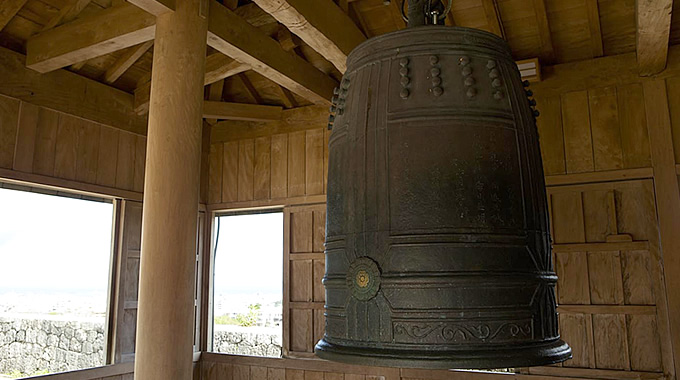
According to historical records, it is documented that this bell was set at the Seiden of Shurijo Castle in 1458, but since it is not clear exactly where it was placed, the bell has been placed at the present location for the time being.
This is a replica of “The Bridge of Nations Bell” which is housed at the Okinawa Prefectural Museum. Inscriptions on the bell describe the proud Kingdom of the Ryukyus as a maritime state, which can be summarized as follows: “The Ryukyu Kingdom is a land of beauty in the southern seas between Korea, China and Japan. With its ships, it bridges the nations and the Kingdom prospers through trade.”
© Shurijo Castle Park All Rights Reserved.

